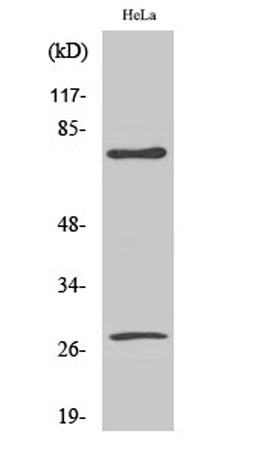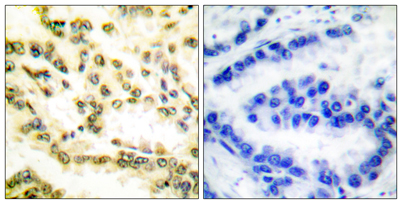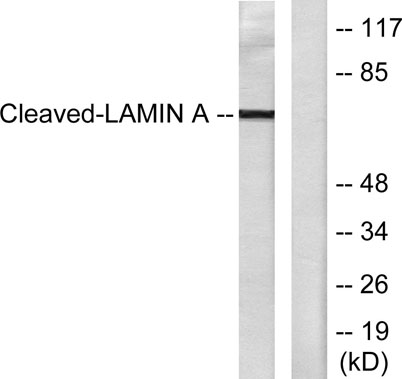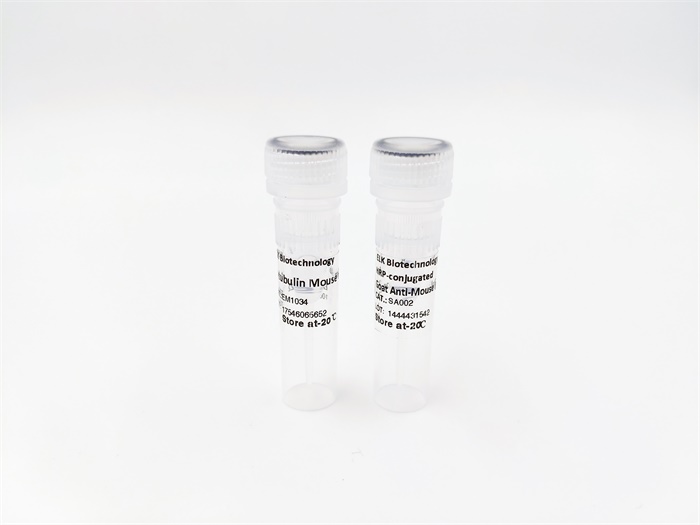| Product name: |
Cleaved-Lamin A (D230) rabbit pAb |
| Reactivity: |
Human;Mouse;Rat |
| Alternative Names: |
LMNA; LMN1; Prelamin-A/C |
| Source: |
Rabbit |
| Dilutions: |
Western Blot: 1/500 - 1/2000. Immunohistochemistry: 1/100 - 1/300. ELISA: 1/10000. Not yet tested in other applications. |
| Immunogen: |
The antiserum was produced against synthesized peptide derived from human Lamin A. AA range:181-230 |
| Storage: |
-20°C/1 year |
| Clonality: |
Polyclonal |
| Isotype: |
IgG |
| Concentration: |
1 mg/ml |
| Observed Band: |
28+75kD |
| GeneID: |
4000 |
| Human Swiss-Prot No: |
P02545 |
| Cellular localization: |
Nucleus . Nucleus envelope . Nucleus lamina. Nucleus, nucleoplasm. Nucleus matrix . Farnesylation of prelamin-A/C facilitates nuclear envelope targeting and subsequent cleavage by ZMPSTE24/FACE1 to remove the farnesyl group produces mature lamin-A/C, which can then be inserted into the nuclear lamina. EMD is required for proper localization of non-farnesylated prelamin-A/C.; [Isoform C]: Nucleus speckle . |
| Background: |
lamin A/C(LMNA) Homo sapiens The nuclear lamina consists of a two-dimensional matrix of proteins located next to the inner nuclear membrane. The lamin family of proteins make up the matrix and are highly conserved in evolution. During mitosis, the lamina matrix is reversibly disassembled as the lamin proteins are phosphorylated. Lamin proteins are thought to be involved in nuclear stability, chromatin structure and gene expression. Vertebrate lamins consist of two types, A and B. Alternative splicing results in multiple transcript variants. Mutations in this gene lead to several diseases: Emery-Dreifuss muscular dystrophy, familial partial lipodystrophy, limb girdle muscular dystrophy, dilated cardiomyopathy, Charcot-Marie-Tooth disease, and Hutchinson-Gilford progeria syndrome. [provided by RefSeq, Apr 2012], |




 Western Blot analysis of various cells using Cleaved-Lamin A (D230) Polyclonal Antibody
Western Blot analysis of various cells using Cleaved-Lamin A (D230) Polyclonal Antibody Immunohistochemistry analysis of paraffin-embedded human lung carcinoma tissue, using Lamin A (Cleaved-Asp230) Antibody. The picture on the right is blocked with the synthesized peptide.
Immunohistochemistry analysis of paraffin-embedded human lung carcinoma tissue, using Lamin A (Cleaved-Asp230) Antibody. The picture on the right is blocked with the synthesized peptide. Western blot analysis of lysates from HeLa cells, treated with Etoposide 25uM 60', using Lamin A (Cleaved-Asp230) Antibody. The lane on the right is blocked with the synthesized peptide.
Western blot analysis of lysates from HeLa cells, treated with Etoposide 25uM 60', using Lamin A (Cleaved-Asp230) Antibody. The lane on the right is blocked with the synthesized peptide.在線咨詢
技術(shù)支持



 下載說(shuō)明 ①
下載說(shuō)明 ①



